Investigating Depression in Elderly People at Care Homes: A Report
VerifiedAdded on 2022/10/27
|14
|3880
|20
Report
AI Summary
This report investigates depression among elderly individuals residing in care homes, highlighting its prevalence and impact on their mental and physical well-being. It identifies key factors contributing to depression, including social isolation, loneliness, lack of physical exercise, absence of family interaction, and reduced engagement with culture and religion. The report proposes several solutions, such as hiring trained staff to provide emotional support and encourage physical activities, fostering family connections, and promoting social interaction. Furthermore, it emphasizes the effectiveness of cognitive behavioral therapy and interpersonal therapy in treating depression by addressing negative thoughts and improving interpersonal relationships. The research also outlines specific research objectives, questions, and methodologies, including qualitative research design and an inductive approach, to gain a deeper understanding of the issue and propose effective interventions.

Name
Date
Date
Paraphrase This Document
Need a fresh take? Get an instant paraphrase of this document with our AI Paraphraser
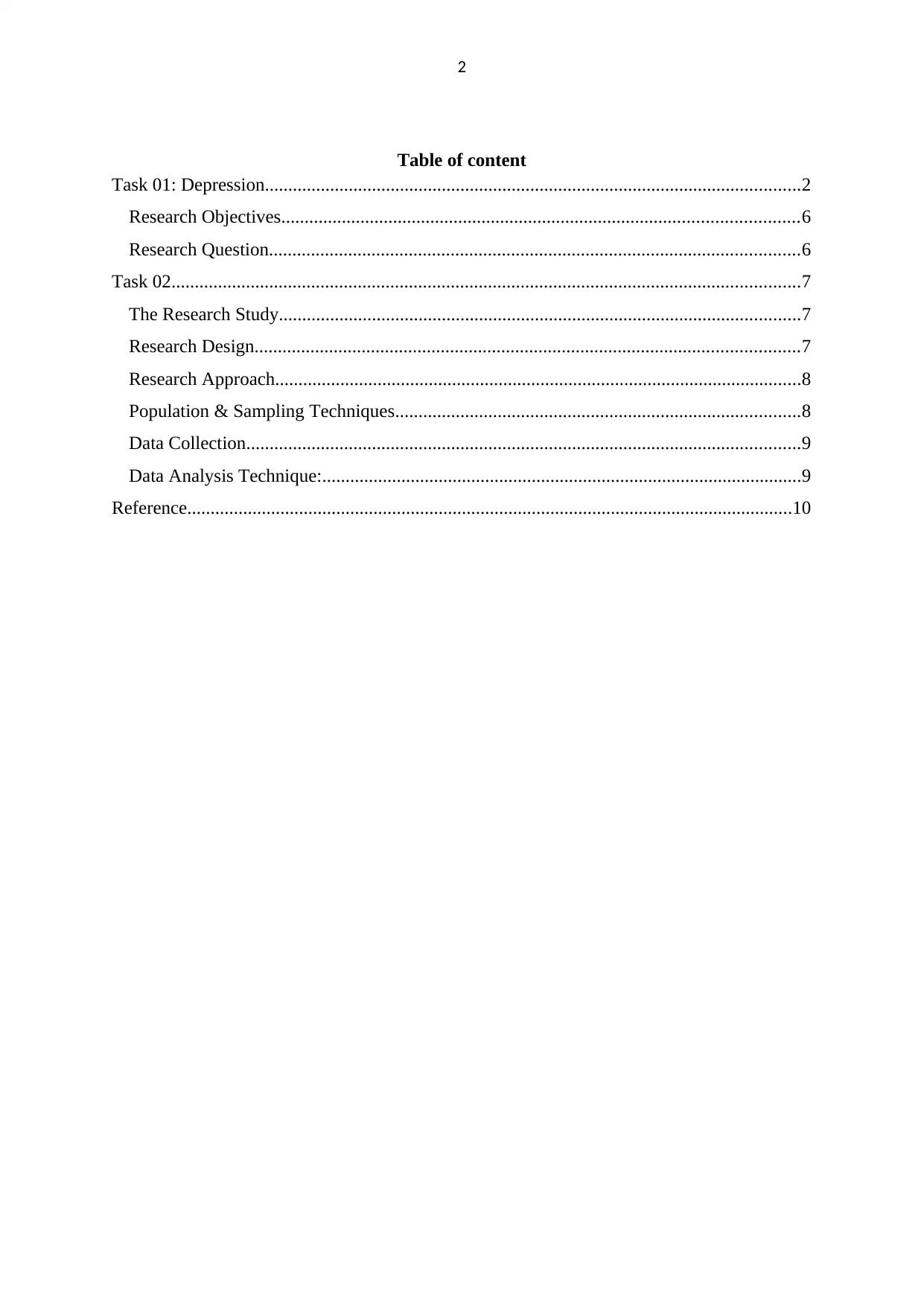
2
Table of content
Task 01: Depression...................................................................................................................2
Research Objectives...............................................................................................................6
Research Question..................................................................................................................6
Task 02.......................................................................................................................................7
The Research Study................................................................................................................7
Research Design.....................................................................................................................7
Research Approach.................................................................................................................8
Population & Sampling Techniques.......................................................................................8
Data Collection.......................................................................................................................9
Data Analysis Technique:.......................................................................................................9
Reference..................................................................................................................................10
Table of content
Task 01: Depression...................................................................................................................2
Research Objectives...............................................................................................................6
Research Question..................................................................................................................6
Task 02.......................................................................................................................................7
The Research Study................................................................................................................7
Research Design.....................................................................................................................7
Research Approach.................................................................................................................8
Population & Sampling Techniques.......................................................................................8
Data Collection.......................................................................................................................9
Data Analysis Technique:.......................................................................................................9
Reference..................................................................................................................................10
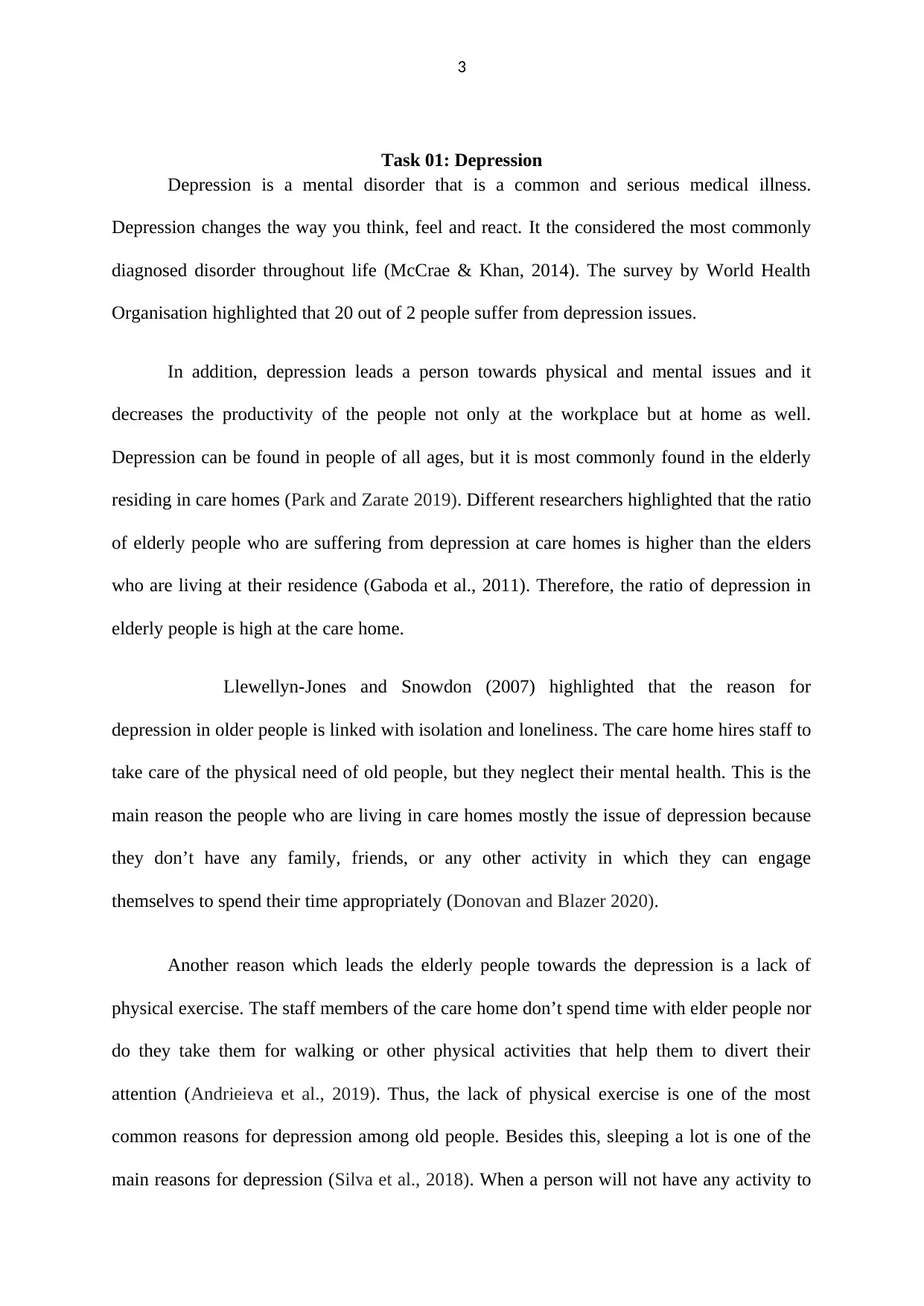
3
Task 01: Depression
Depression is a mental disorder that is a common and serious medical illness.
Depression changes the way you think, feel and react. It the considered the most commonly
diagnosed disorder throughout life (McCrae & Khan, 2014). The survey by World Health
Organisation highlighted that 20 out of 2 people suffer from depression issues.
In addition, depression leads a person towards physical and mental issues and it
decreases the productivity of the people not only at the workplace but at home as well.
Depression can be found in people of all ages, but it is most commonly found in the elderly
residing in care homes (Park and Zarate 2019). Different researchers highlighted that the ratio
of elderly people who are suffering from depression at care homes is higher than the elders
who are living at their residence (Gaboda et al., 2011). Therefore, the ratio of depression in
elderly people is high at the care home.
Llewellyn-Jones and Snowdon (2007) highlighted that the reason for
depression in older people is linked with isolation and loneliness. The care home hires staff to
take care of the physical need of old people, but they neglect their mental health. This is the
main reason the people who are living in care homes mostly the issue of depression because
they don’t have any family, friends, or any other activity in which they can engage
themselves to spend their time appropriately (Donovan and Blazer 2020).
Another reason which leads the elderly people towards the depression is a lack of
physical exercise. The staff members of the care home don’t spend time with elder people nor
do they take them for walking or other physical activities that help them to divert their
attention (Andrieieva et al., 2019). Thus, the lack of physical exercise is one of the most
common reasons for depression among old people. Besides this, sleeping a lot is one of the
main reasons for depression (Silva et al., 2018). When a person will not have any activity to
Task 01: Depression
Depression is a mental disorder that is a common and serious medical illness.
Depression changes the way you think, feel and react. It the considered the most commonly
diagnosed disorder throughout life (McCrae & Khan, 2014). The survey by World Health
Organisation highlighted that 20 out of 2 people suffer from depression issues.
In addition, depression leads a person towards physical and mental issues and it
decreases the productivity of the people not only at the workplace but at home as well.
Depression can be found in people of all ages, but it is most commonly found in the elderly
residing in care homes (Park and Zarate 2019). Different researchers highlighted that the ratio
of elderly people who are suffering from depression at care homes is higher than the elders
who are living at their residence (Gaboda et al., 2011). Therefore, the ratio of depression in
elderly people is high at the care home.
Llewellyn-Jones and Snowdon (2007) highlighted that the reason for
depression in older people is linked with isolation and loneliness. The care home hires staff to
take care of the physical need of old people, but they neglect their mental health. This is the
main reason the people who are living in care homes mostly the issue of depression because
they don’t have any family, friends, or any other activity in which they can engage
themselves to spend their time appropriately (Donovan and Blazer 2020).
Another reason which leads the elderly people towards the depression is a lack of
physical exercise. The staff members of the care home don’t spend time with elder people nor
do they take them for walking or other physical activities that help them to divert their
attention (Andrieieva et al., 2019). Thus, the lack of physical exercise is one of the most
common reasons for depression among old people. Besides this, sleeping a lot is one of the
main reasons for depression (Silva et al., 2018). When a person will not have any activity to
⊘ This is a preview!⊘
Do you want full access?
Subscribe today to unlock all pages.

Trusted by 1+ million students worldwide
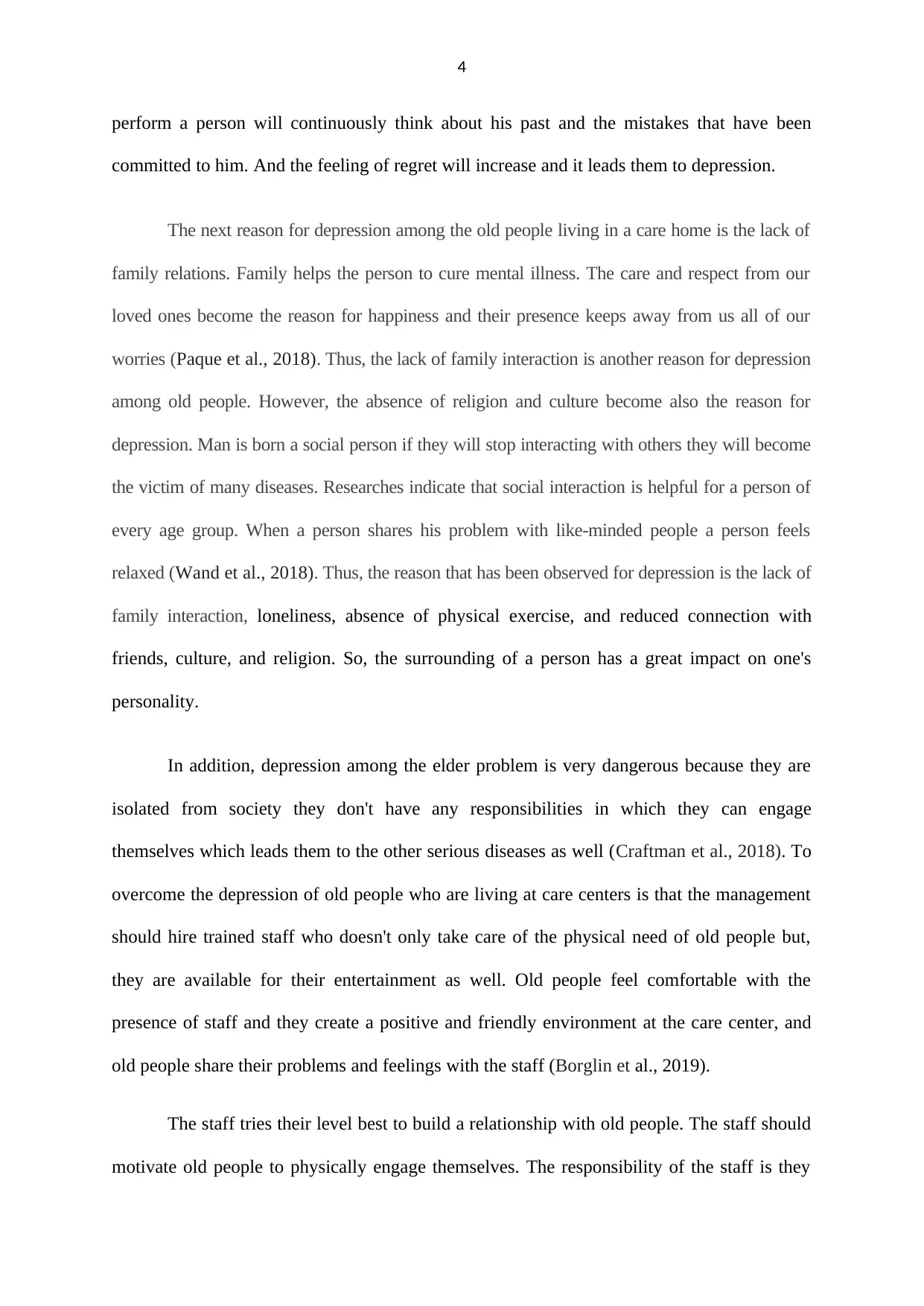
4
perform a person will continuously think about his past and the mistakes that have been
committed to him. And the feeling of regret will increase and it leads them to depression.
The next reason for depression among the old people living in a care home is the lack of
family relations. Family helps the person to cure mental illness. The care and respect from our
loved ones become the reason for happiness and their presence keeps away from us all of our
worries (Paque et al., 2018). Thus, the lack of family interaction is another reason for depression
among old people. However, the absence of religion and culture become also the reason for
depression. Man is born a social person if they will stop interacting with others they will become
the victim of many diseases. Researches indicate that social interaction is helpful for a person of
every age group. When a person shares his problem with like-minded people a person feels
relaxed (Wand et al., 2018). Thus, the reason that has been observed for depression is the lack of
family interaction, loneliness, absence of physical exercise, and reduced connection with
friends, culture, and religion. So, the surrounding of a person has a great impact on one's
personality.
In addition, depression among the elder problem is very dangerous because they are
isolated from society they don't have any responsibilities in which they can engage
themselves which leads them to the other serious diseases as well (Craftman et al., 2018). To
overcome the depression of old people who are living at care centers is that the management
should hire trained staff who doesn't only take care of the physical need of old people but,
they are available for their entertainment as well. Old people feel comfortable with the
presence of staff and they create a positive and friendly environment at the care center, and
old people share their problems and feelings with the staff (Borglin et al., 2019).
The staff tries their level best to build a relationship with old people. The staff should
motivate old people to physically engage themselves. The responsibility of the staff is they
perform a person will continuously think about his past and the mistakes that have been
committed to him. And the feeling of regret will increase and it leads them to depression.
The next reason for depression among the old people living in a care home is the lack of
family relations. Family helps the person to cure mental illness. The care and respect from our
loved ones become the reason for happiness and their presence keeps away from us all of our
worries (Paque et al., 2018). Thus, the lack of family interaction is another reason for depression
among old people. However, the absence of religion and culture become also the reason for
depression. Man is born a social person if they will stop interacting with others they will become
the victim of many diseases. Researches indicate that social interaction is helpful for a person of
every age group. When a person shares his problem with like-minded people a person feels
relaxed (Wand et al., 2018). Thus, the reason that has been observed for depression is the lack of
family interaction, loneliness, absence of physical exercise, and reduced connection with
friends, culture, and religion. So, the surrounding of a person has a great impact on one's
personality.
In addition, depression among the elder problem is very dangerous because they are
isolated from society they don't have any responsibilities in which they can engage
themselves which leads them to the other serious diseases as well (Craftman et al., 2018). To
overcome the depression of old people who are living at care centers is that the management
should hire trained staff who doesn't only take care of the physical need of old people but,
they are available for their entertainment as well. Old people feel comfortable with the
presence of staff and they create a positive and friendly environment at the care center, and
old people share their problems and feelings with the staff (Borglin et al., 2019).
The staff tries their level best to build a relationship with old people. The staff should
motivate old people to physically engage themselves. The responsibility of the staff is they
Paraphrase This Document
Need a fresh take? Get an instant paraphrase of this document with our AI Paraphraser
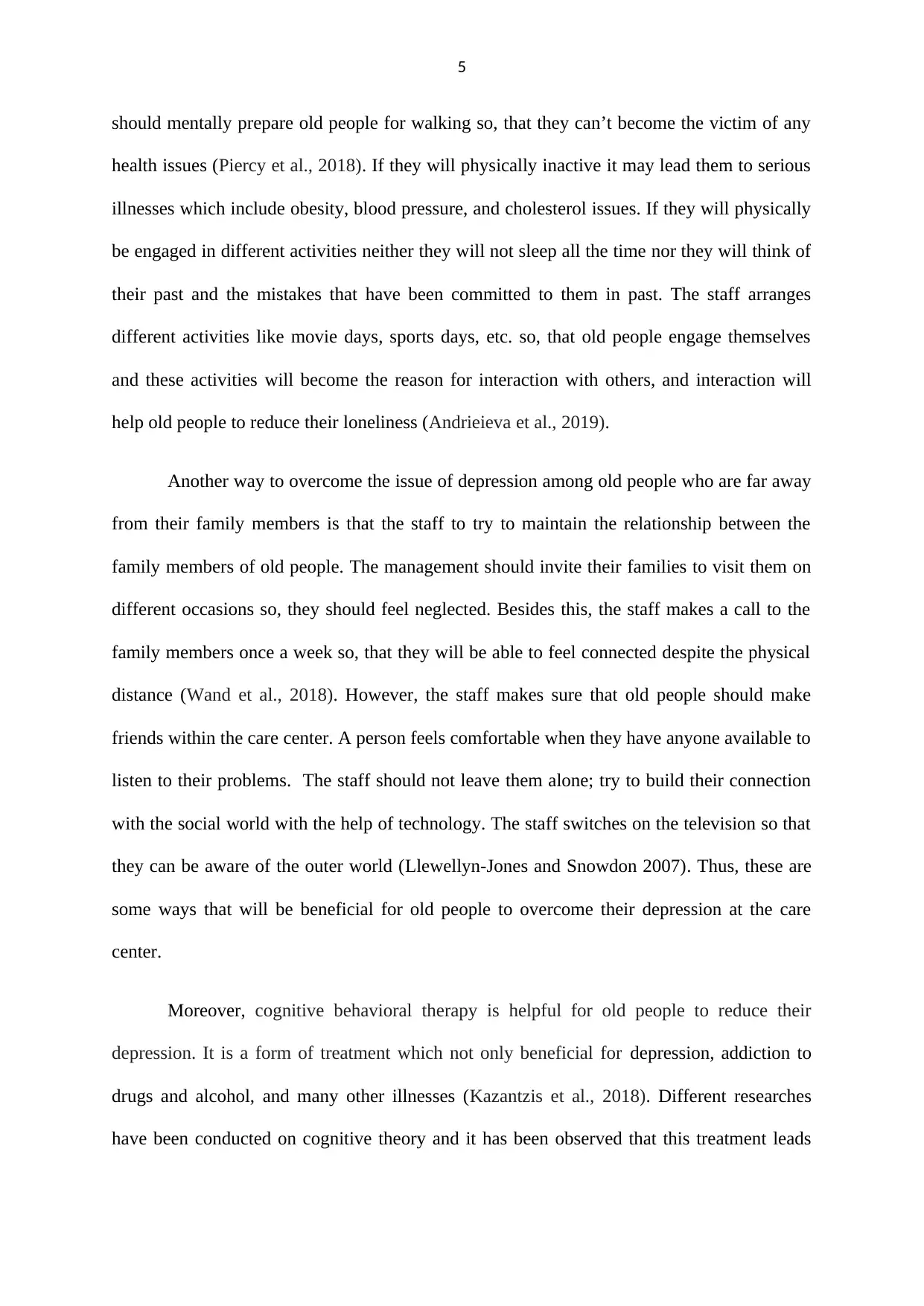
5
should mentally prepare old people for walking so, that they can’t become the victim of any
health issues (Piercy et al., 2018). If they will physically inactive it may lead them to serious
illnesses which include obesity, blood pressure, and cholesterol issues. If they will physically
be engaged in different activities neither they will not sleep all the time nor they will think of
their past and the mistakes that have been committed to them in past. The staff arranges
different activities like movie days, sports days, etc. so, that old people engage themselves
and these activities will become the reason for interaction with others, and interaction will
help old people to reduce their loneliness (Andrieieva et al., 2019).
Another way to overcome the issue of depression among old people who are far away
from their family members is that the staff to try to maintain the relationship between the
family members of old people. The management should invite their families to visit them on
different occasions so, they should feel neglected. Besides this, the staff makes a call to the
family members once a week so, that they will be able to feel connected despite the physical
distance (Wand et al., 2018). However, the staff makes sure that old people should make
friends within the care center. A person feels comfortable when they have anyone available to
listen to their problems. The staff should not leave them alone; try to build their connection
with the social world with the help of technology. The staff switches on the television so that
they can be aware of the outer world (Llewellyn-Jones and Snowdon 2007). Thus, these are
some ways that will be beneficial for old people to overcome their depression at the care
center.
Moreover, cognitive behavioral therapy is helpful for old people to reduce their
depression. It is a form of treatment which not only beneficial for depression, addiction to
drugs and alcohol, and many other illnesses (Kazantzis et al., 2018). Different researches
have been conducted on cognitive theory and it has been observed that this treatment leads
should mentally prepare old people for walking so, that they can’t become the victim of any
health issues (Piercy et al., 2018). If they will physically inactive it may lead them to serious
illnesses which include obesity, blood pressure, and cholesterol issues. If they will physically
be engaged in different activities neither they will not sleep all the time nor they will think of
their past and the mistakes that have been committed to them in past. The staff arranges
different activities like movie days, sports days, etc. so, that old people engage themselves
and these activities will become the reason for interaction with others, and interaction will
help old people to reduce their loneliness (Andrieieva et al., 2019).
Another way to overcome the issue of depression among old people who are far away
from their family members is that the staff to try to maintain the relationship between the
family members of old people. The management should invite their families to visit them on
different occasions so, they should feel neglected. Besides this, the staff makes a call to the
family members once a week so, that they will be able to feel connected despite the physical
distance (Wand et al., 2018). However, the staff makes sure that old people should make
friends within the care center. A person feels comfortable when they have anyone available to
listen to their problems. The staff should not leave them alone; try to build their connection
with the social world with the help of technology. The staff switches on the television so that
they can be aware of the outer world (Llewellyn-Jones and Snowdon 2007). Thus, these are
some ways that will be beneficial for old people to overcome their depression at the care
center.
Moreover, cognitive behavioral therapy is helpful for old people to reduce their
depression. It is a form of treatment which not only beneficial for depression, addiction to
drugs and alcohol, and many other illnesses (Kazantzis et al., 2018). Different researches
have been conducted on cognitive theory and it has been observed that this treatment leads
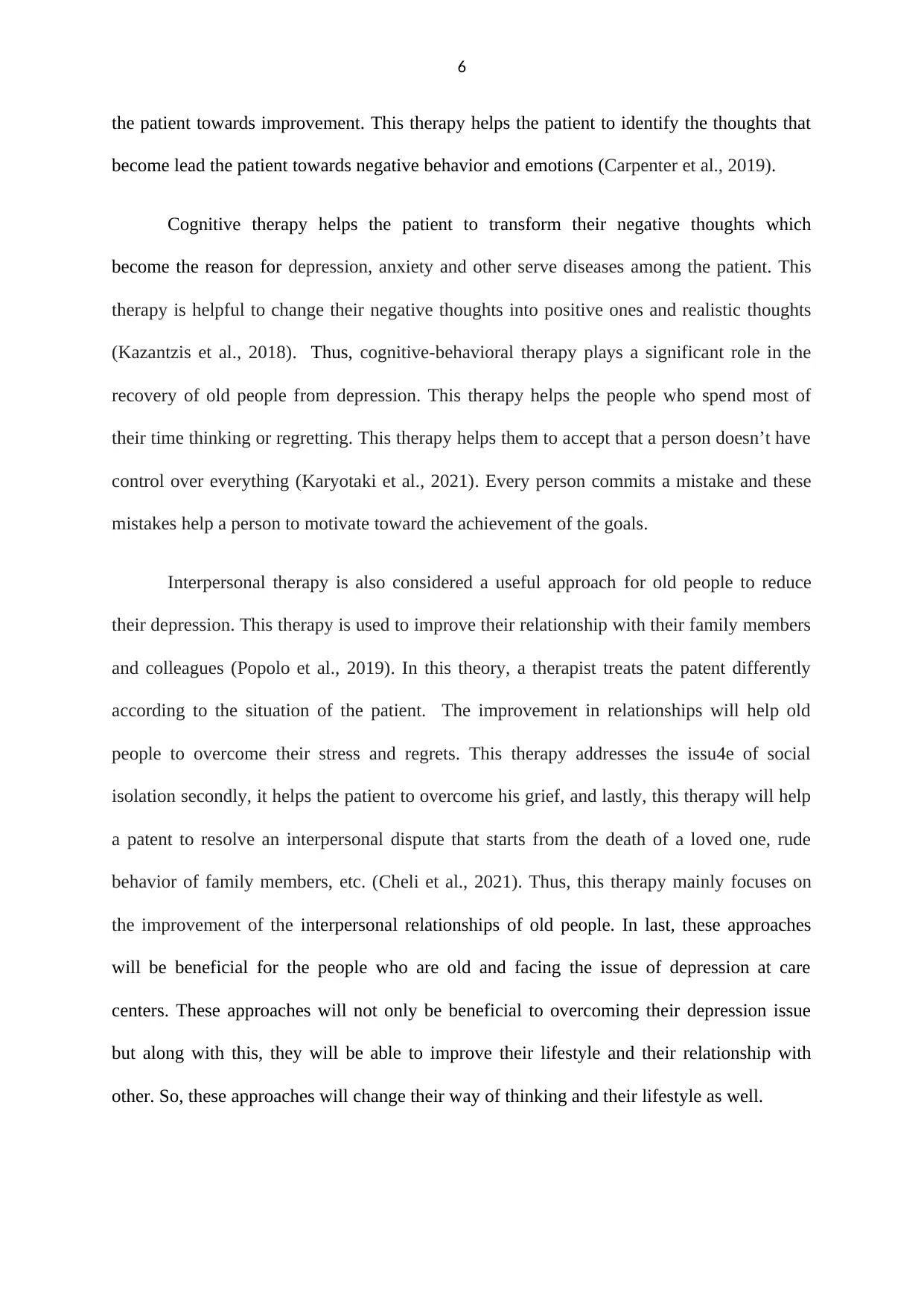
6
the patient towards improvement. This therapy helps the patient to identify the thoughts that
become lead the patient towards negative behavior and emotions (Carpenter et al., 2019).
Cognitive therapy helps the patient to transform their negative thoughts which
become the reason for depression, anxiety and other serve diseases among the patient. This
therapy is helpful to change their negative thoughts into positive ones and realistic thoughts
(Kazantzis et al., 2018). Thus, cognitive-behavioral therapy plays a significant role in the
recovery of old people from depression. This therapy helps the people who spend most of
their time thinking or regretting. This therapy helps them to accept that a person doesn’t have
control over everything (Karyotaki et al., 2021). Every person commits a mistake and these
mistakes help a person to motivate toward the achievement of the goals.
Interpersonal therapy is also considered a useful approach for old people to reduce
their depression. This therapy is used to improve their relationship with their family members
and colleagues (Popolo et al., 2019). In this theory, a therapist treats the patent differently
according to the situation of the patient. The improvement in relationships will help old
people to overcome their stress and regrets. This therapy addresses the issu4e of social
isolation secondly, it helps the patient to overcome his grief, and lastly, this therapy will help
a patent to resolve an interpersonal dispute that starts from the death of a loved one, rude
behavior of family members, etc. (Cheli et al., 2021). Thus, this therapy mainly focuses on
the improvement of the interpersonal relationships of old people. In last, these approaches
will be beneficial for the people who are old and facing the issue of depression at care
centers. These approaches will not only be beneficial to overcoming their depression issue
but along with this, they will be able to improve their lifestyle and their relationship with
other. So, these approaches will change their way of thinking and their lifestyle as well.
the patient towards improvement. This therapy helps the patient to identify the thoughts that
become lead the patient towards negative behavior and emotions (Carpenter et al., 2019).
Cognitive therapy helps the patient to transform their negative thoughts which
become the reason for depression, anxiety and other serve diseases among the patient. This
therapy is helpful to change their negative thoughts into positive ones and realistic thoughts
(Kazantzis et al., 2018). Thus, cognitive-behavioral therapy plays a significant role in the
recovery of old people from depression. This therapy helps the people who spend most of
their time thinking or regretting. This therapy helps them to accept that a person doesn’t have
control over everything (Karyotaki et al., 2021). Every person commits a mistake and these
mistakes help a person to motivate toward the achievement of the goals.
Interpersonal therapy is also considered a useful approach for old people to reduce
their depression. This therapy is used to improve their relationship with their family members
and colleagues (Popolo et al., 2019). In this theory, a therapist treats the patent differently
according to the situation of the patient. The improvement in relationships will help old
people to overcome their stress and regrets. This therapy addresses the issu4e of social
isolation secondly, it helps the patient to overcome his grief, and lastly, this therapy will help
a patent to resolve an interpersonal dispute that starts from the death of a loved one, rude
behavior of family members, etc. (Cheli et al., 2021). Thus, this therapy mainly focuses on
the improvement of the interpersonal relationships of old people. In last, these approaches
will be beneficial for the people who are old and facing the issue of depression at care
centers. These approaches will not only be beneficial to overcoming their depression issue
but along with this, they will be able to improve their lifestyle and their relationship with
other. So, these approaches will change their way of thinking and their lifestyle as well.
⊘ This is a preview!⊘
Do you want full access?
Subscribe today to unlock all pages.

Trusted by 1+ million students worldwide
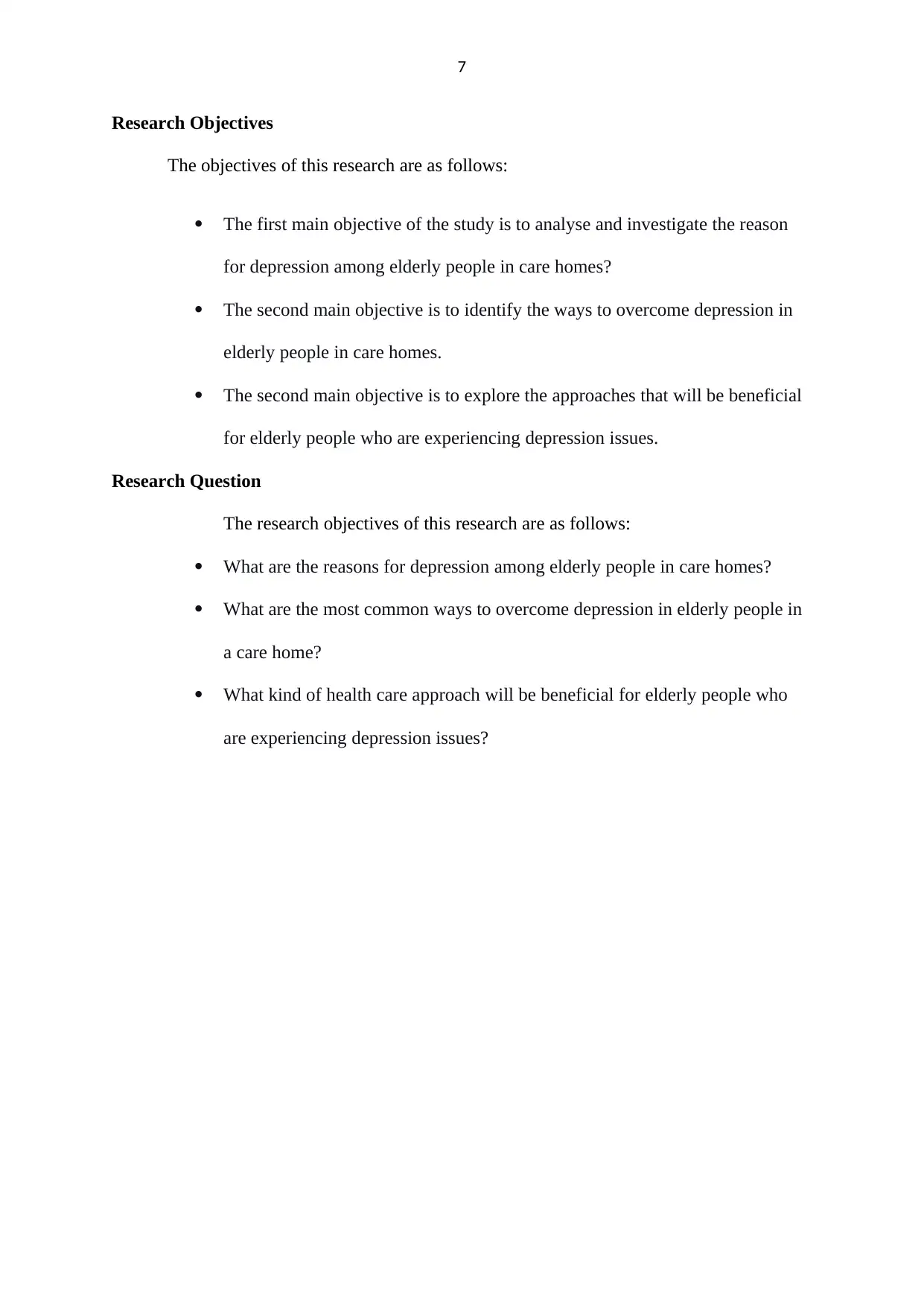
7
Research Objectives
The objectives of this research are as follows:
The first main objective of the study is to analyse and investigate the reason
for depression among elderly people in care homes?
The second main objective is to identify the ways to overcome depression in
elderly people in care homes.
The second main objective is to explore the approaches that will be beneficial
for elderly people who are experiencing depression issues.
Research Question
The research objectives of this research are as follows:
What are the reasons for depression among elderly people in care homes?
What are the most common ways to overcome depression in elderly people in
a care home?
What kind of health care approach will be beneficial for elderly people who
are experiencing depression issues?
Research Objectives
The objectives of this research are as follows:
The first main objective of the study is to analyse and investigate the reason
for depression among elderly people in care homes?
The second main objective is to identify the ways to overcome depression in
elderly people in care homes.
The second main objective is to explore the approaches that will be beneficial
for elderly people who are experiencing depression issues.
Research Question
The research objectives of this research are as follows:
What are the reasons for depression among elderly people in care homes?
What are the most common ways to overcome depression in elderly people in
a care home?
What kind of health care approach will be beneficial for elderly people who
are experiencing depression issues?
Paraphrase This Document
Need a fresh take? Get an instant paraphrase of this document with our AI Paraphraser
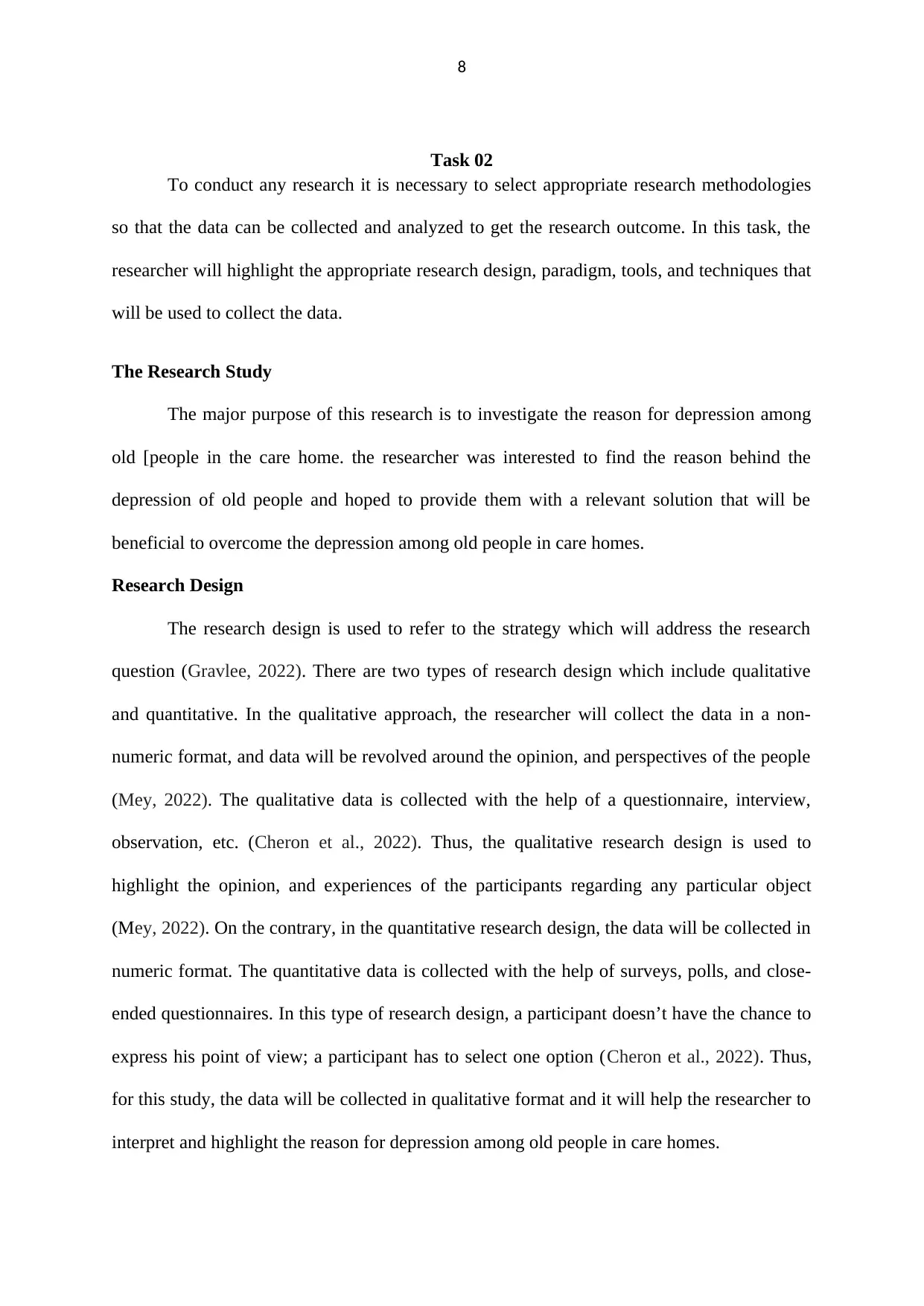
8
Task 02
To conduct any research it is necessary to select appropriate research methodologies
so that the data can be collected and analyzed to get the research outcome. In this task, the
researcher will highlight the appropriate research design, paradigm, tools, and techniques that
will be used to collect the data.
The Research Study
The major purpose of this research is to investigate the reason for depression among
old [people in the care home. the researcher was interested to find the reason behind the
depression of old people and hoped to provide them with a relevant solution that will be
beneficial to overcome the depression among old people in care homes.
Research Design
The research design is used to refer to the strategy which will address the research
question (Gravlee, 2022). There are two types of research design which include qualitative
and quantitative. In the qualitative approach, the researcher will collect the data in a non-
numeric format, and data will be revolved around the opinion, and perspectives of the people
(Mey, 2022). The qualitative data is collected with the help of a questionnaire, interview,
observation, etc. (Cheron et al., 2022). Thus, the qualitative research design is used to
highlight the opinion, and experiences of the participants regarding any particular object
(Mey, 2022). On the contrary, in the quantitative research design, the data will be collected in
numeric format. The quantitative data is collected with the help of surveys, polls, and close-
ended questionnaires. In this type of research design, a participant doesn’t have the chance to
express his point of view; a participant has to select one option (Cheron et al., 2022). Thus,
for this study, the data will be collected in qualitative format and it will help the researcher to
interpret and highlight the reason for depression among old people in care homes.
Task 02
To conduct any research it is necessary to select appropriate research methodologies
so that the data can be collected and analyzed to get the research outcome. In this task, the
researcher will highlight the appropriate research design, paradigm, tools, and techniques that
will be used to collect the data.
The Research Study
The major purpose of this research is to investigate the reason for depression among
old [people in the care home. the researcher was interested to find the reason behind the
depression of old people and hoped to provide them with a relevant solution that will be
beneficial to overcome the depression among old people in care homes.
Research Design
The research design is used to refer to the strategy which will address the research
question (Gravlee, 2022). There are two types of research design which include qualitative
and quantitative. In the qualitative approach, the researcher will collect the data in a non-
numeric format, and data will be revolved around the opinion, and perspectives of the people
(Mey, 2022). The qualitative data is collected with the help of a questionnaire, interview,
observation, etc. (Cheron et al., 2022). Thus, the qualitative research design is used to
highlight the opinion, and experiences of the participants regarding any particular object
(Mey, 2022). On the contrary, in the quantitative research design, the data will be collected in
numeric format. The quantitative data is collected with the help of surveys, polls, and close-
ended questionnaires. In this type of research design, a participant doesn’t have the chance to
express his point of view; a participant has to select one option (Cheron et al., 2022). Thus,
for this study, the data will be collected in qualitative format and it will help the researcher to
interpret and highlight the reason for depression among old people in care homes.

9
⊘ This is a preview!⊘
Do you want full access?
Subscribe today to unlock all pages.

Trusted by 1+ million students worldwide
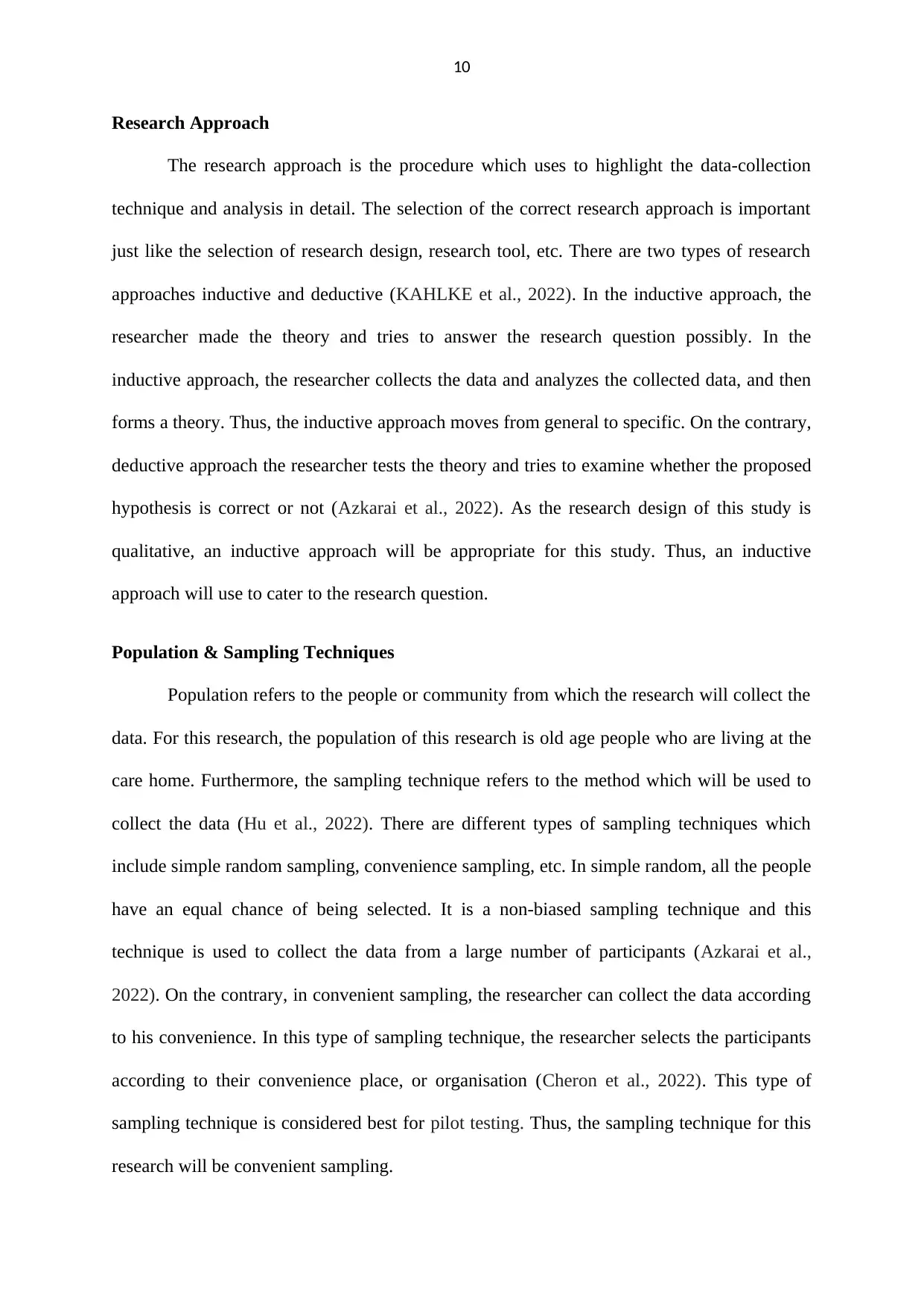
10
Research Approach
The research approach is the procedure which uses to highlight the data-collection
technique and analysis in detail. The selection of the correct research approach is important
just like the selection of research design, research tool, etc. There are two types of research
approaches inductive and deductive (KAHLKE et al., 2022). In the inductive approach, the
researcher made the theory and tries to answer the research question possibly. In the
inductive approach, the researcher collects the data and analyzes the collected data, and then
forms a theory. Thus, the inductive approach moves from general to specific. On the contrary,
deductive approach the researcher tests the theory and tries to examine whether the proposed
hypothesis is correct or not (Azkarai et al., 2022). As the research design of this study is
qualitative, an inductive approach will be appropriate for this study. Thus, an inductive
approach will use to cater to the research question.
Population & Sampling Techniques
Population refers to the people or community from which the research will collect the
data. For this research, the population of this research is old age people who are living at the
care home. Furthermore, the sampling technique refers to the method which will be used to
collect the data (Hu et al., 2022). There are different types of sampling techniques which
include simple random sampling, convenience sampling, etc. In simple random, all the people
have an equal chance of being selected. It is a non-biased sampling technique and this
technique is used to collect the data from a large number of participants (Azkarai et al.,
2022). On the contrary, in convenient sampling, the researcher can collect the data according
to his convenience. In this type of sampling technique, the researcher selects the participants
according to their convenience place, or organisation (Cheron et al., 2022). This type of
sampling technique is considered best for pilot testing. Thus, the sampling technique for this
research will be convenient sampling.
Research Approach
The research approach is the procedure which uses to highlight the data-collection
technique and analysis in detail. The selection of the correct research approach is important
just like the selection of research design, research tool, etc. There are two types of research
approaches inductive and deductive (KAHLKE et al., 2022). In the inductive approach, the
researcher made the theory and tries to answer the research question possibly. In the
inductive approach, the researcher collects the data and analyzes the collected data, and then
forms a theory. Thus, the inductive approach moves from general to specific. On the contrary,
deductive approach the researcher tests the theory and tries to examine whether the proposed
hypothesis is correct or not (Azkarai et al., 2022). As the research design of this study is
qualitative, an inductive approach will be appropriate for this study. Thus, an inductive
approach will use to cater to the research question.
Population & Sampling Techniques
Population refers to the people or community from which the research will collect the
data. For this research, the population of this research is old age people who are living at the
care home. Furthermore, the sampling technique refers to the method which will be used to
collect the data (Hu et al., 2022). There are different types of sampling techniques which
include simple random sampling, convenience sampling, etc. In simple random, all the people
have an equal chance of being selected. It is a non-biased sampling technique and this
technique is used to collect the data from a large number of participants (Azkarai et al.,
2022). On the contrary, in convenient sampling, the researcher can collect the data according
to his convenience. In this type of sampling technique, the researcher selects the participants
according to their convenience place, or organisation (Cheron et al., 2022). This type of
sampling technique is considered best for pilot testing. Thus, the sampling technique for this
research will be convenient sampling.
Paraphrase This Document
Need a fresh take? Get an instant paraphrase of this document with our AI Paraphraser
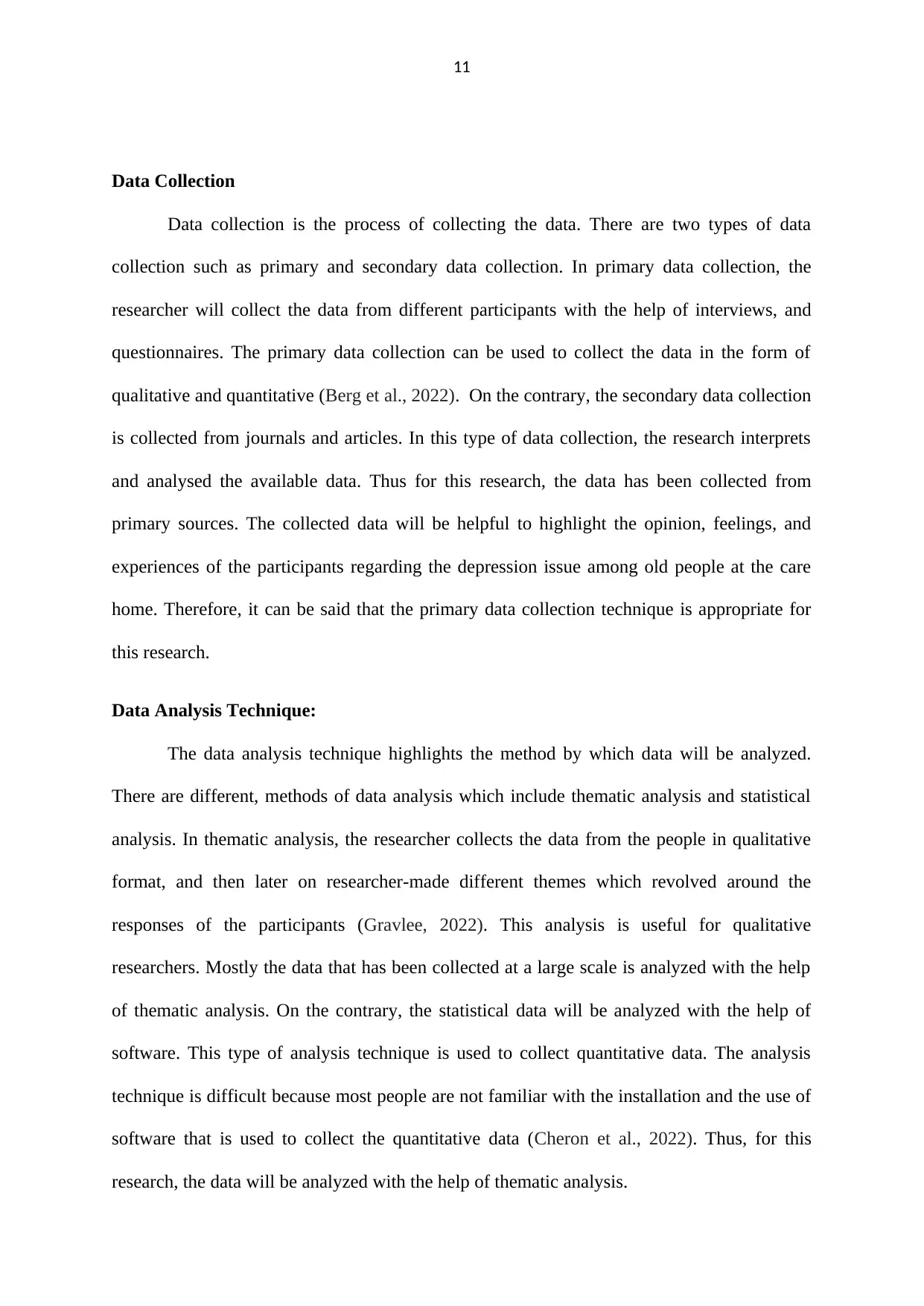
11
Data Collection
Data collection is the process of collecting the data. There are two types of data
collection such as primary and secondary data collection. In primary data collection, the
researcher will collect the data from different participants with the help of interviews, and
questionnaires. The primary data collection can be used to collect the data in the form of
qualitative and quantitative (Berg et al., 2022). On the contrary, the secondary data collection
is collected from journals and articles. In this type of data collection, the research interprets
and analysed the available data. Thus for this research, the data has been collected from
primary sources. The collected data will be helpful to highlight the opinion, feelings, and
experiences of the participants regarding the depression issue among old people at the care
home. Therefore, it can be said that the primary data collection technique is appropriate for
this research.
Data Analysis Technique:
The data analysis technique highlights the method by which data will be analyzed.
There are different, methods of data analysis which include thematic analysis and statistical
analysis. In thematic analysis, the researcher collects the data from the people in qualitative
format, and then later on researcher-made different themes which revolved around the
responses of the participants (Gravlee, 2022). This analysis is useful for qualitative
researchers. Mostly the data that has been collected at a large scale is analyzed with the help
of thematic analysis. On the contrary, the statistical data will be analyzed with the help of
software. This type of analysis technique is used to collect quantitative data. The analysis
technique is difficult because most people are not familiar with the installation and the use of
software that is used to collect the quantitative data (Cheron et al., 2022). Thus, for this
research, the data will be analyzed with the help of thematic analysis.
Data Collection
Data collection is the process of collecting the data. There are two types of data
collection such as primary and secondary data collection. In primary data collection, the
researcher will collect the data from different participants with the help of interviews, and
questionnaires. The primary data collection can be used to collect the data in the form of
qualitative and quantitative (Berg et al., 2022). On the contrary, the secondary data collection
is collected from journals and articles. In this type of data collection, the research interprets
and analysed the available data. Thus for this research, the data has been collected from
primary sources. The collected data will be helpful to highlight the opinion, feelings, and
experiences of the participants regarding the depression issue among old people at the care
home. Therefore, it can be said that the primary data collection technique is appropriate for
this research.
Data Analysis Technique:
The data analysis technique highlights the method by which data will be analyzed.
There are different, methods of data analysis which include thematic analysis and statistical
analysis. In thematic analysis, the researcher collects the data from the people in qualitative
format, and then later on researcher-made different themes which revolved around the
responses of the participants (Gravlee, 2022). This analysis is useful for qualitative
researchers. Mostly the data that has been collected at a large scale is analyzed with the help
of thematic analysis. On the contrary, the statistical data will be analyzed with the help of
software. This type of analysis technique is used to collect quantitative data. The analysis
technique is difficult because most people are not familiar with the installation and the use of
software that is used to collect the quantitative data (Cheron et al., 2022). Thus, for this
research, the data will be analyzed with the help of thematic analysis.
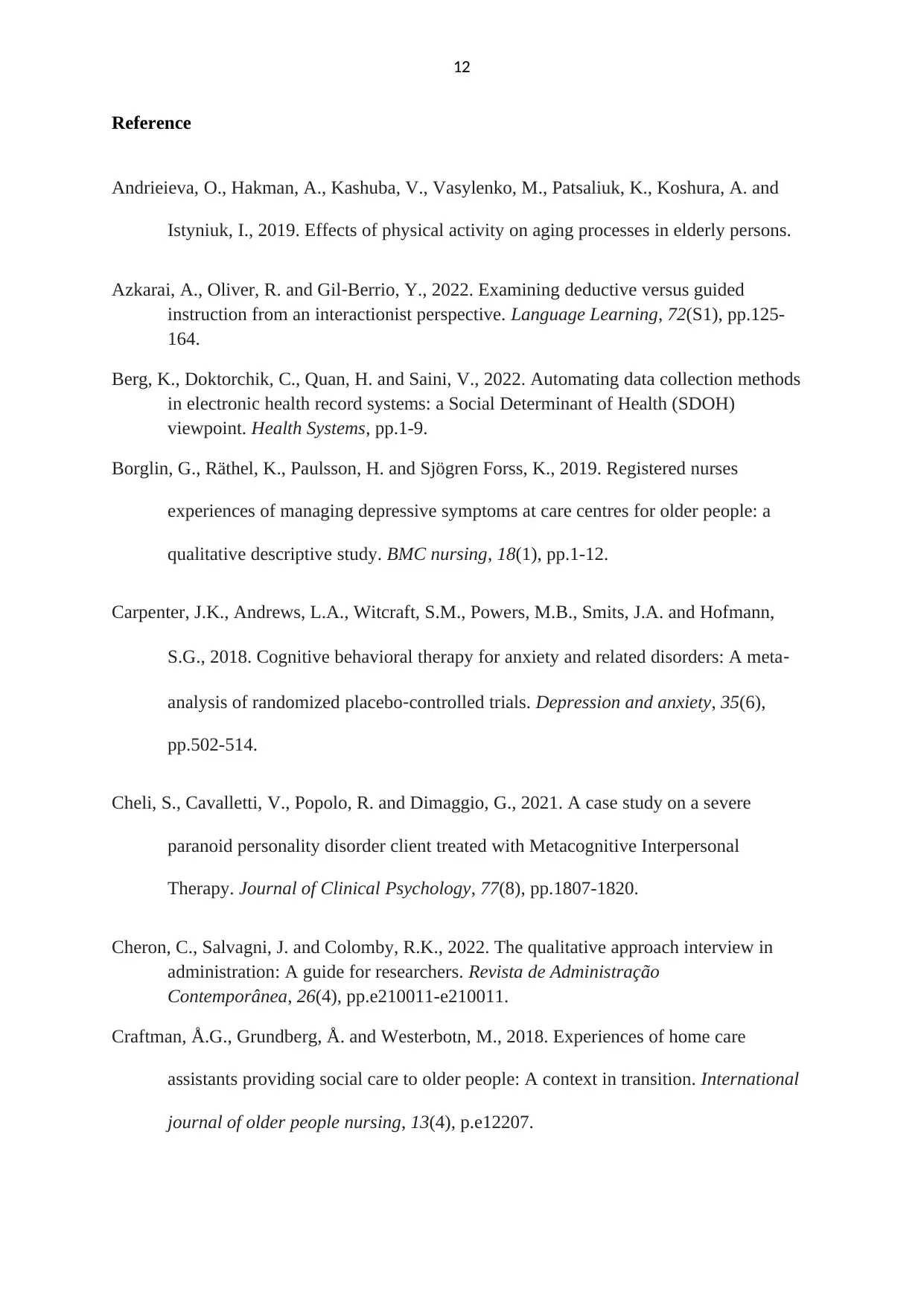
12
Reference
Andrieieva, O., Hakman, А., Kashuba, V., Vasylenko, M., Patsaliuk, K., Koshura, A. and
Istyniuk, I., 2019. Effects of physical activity on aging processes in elderly persons.
Azkarai, A., Oliver, R. and Gil‐Berrio, Y., 2022. Examining deductive versus guided
instruction from an interactionist perspective. Language Learning, 72(S1), pp.125-
164.
Berg, K., Doktorchik, C., Quan, H. and Saini, V., 2022. Automating data collection methods
in electronic health record systems: a Social Determinant of Health (SDOH)
viewpoint. Health Systems, pp.1-9.
Borglin, G., Räthel, K., Paulsson, H. and Sjögren Forss, K., 2019. Registered nurses
experiences of managing depressive symptoms at care centres for older people: a
qualitative descriptive study. BMC nursing, 18(1), pp.1-12.
Carpenter, J.K., Andrews, L.A., Witcraft, S.M., Powers, M.B., Smits, J.A. and Hofmann,
S.G., 2018. Cognitive behavioral therapy for anxiety and related disorders: A meta‐
analysis of randomized placebo‐controlled trials. Depression and anxiety, 35(6),
pp.502-514.
Cheli, S., Cavalletti, V., Popolo, R. and Dimaggio, G., 2021. A case study on a severe
paranoid personality disorder client treated with Metacognitive Interpersonal
Therapy. Journal of Clinical Psychology, 77(8), pp.1807-1820.
Cheron, C., Salvagni, J. and Colomby, R.K., 2022. The qualitative approach interview in
administration: A guide for researchers. Revista de Administração
Contemporânea, 26(4), pp.e210011-e210011.
Craftman, Å.G., Grundberg, Å. and Westerbotn, M., 2018. Experiences of home care
assistants providing social care to older people: A context in transition. International
journal of older people nursing, 13(4), p.e12207.
Reference
Andrieieva, O., Hakman, А., Kashuba, V., Vasylenko, M., Patsaliuk, K., Koshura, A. and
Istyniuk, I., 2019. Effects of physical activity on aging processes in elderly persons.
Azkarai, A., Oliver, R. and Gil‐Berrio, Y., 2022. Examining deductive versus guided
instruction from an interactionist perspective. Language Learning, 72(S1), pp.125-
164.
Berg, K., Doktorchik, C., Quan, H. and Saini, V., 2022. Automating data collection methods
in electronic health record systems: a Social Determinant of Health (SDOH)
viewpoint. Health Systems, pp.1-9.
Borglin, G., Räthel, K., Paulsson, H. and Sjögren Forss, K., 2019. Registered nurses
experiences of managing depressive symptoms at care centres for older people: a
qualitative descriptive study. BMC nursing, 18(1), pp.1-12.
Carpenter, J.K., Andrews, L.A., Witcraft, S.M., Powers, M.B., Smits, J.A. and Hofmann,
S.G., 2018. Cognitive behavioral therapy for anxiety and related disorders: A meta‐
analysis of randomized placebo‐controlled trials. Depression and anxiety, 35(6),
pp.502-514.
Cheli, S., Cavalletti, V., Popolo, R. and Dimaggio, G., 2021. A case study on a severe
paranoid personality disorder client treated with Metacognitive Interpersonal
Therapy. Journal of Clinical Psychology, 77(8), pp.1807-1820.
Cheron, C., Salvagni, J. and Colomby, R.K., 2022. The qualitative approach interview in
administration: A guide for researchers. Revista de Administração
Contemporânea, 26(4), pp.e210011-e210011.
Craftman, Å.G., Grundberg, Å. and Westerbotn, M., 2018. Experiences of home care
assistants providing social care to older people: A context in transition. International
journal of older people nursing, 13(4), p.e12207.
⊘ This is a preview!⊘
Do you want full access?
Subscribe today to unlock all pages.

Trusted by 1+ million students worldwide
1 out of 14
Related Documents
Your All-in-One AI-Powered Toolkit for Academic Success.
+13062052269
info@desklib.com
Available 24*7 on WhatsApp / Email
![[object Object]](/_next/static/media/star-bottom.7253800d.svg)
Unlock your academic potential
Copyright © 2020–2025 A2Z Services. All Rights Reserved. Developed and managed by ZUCOL.





